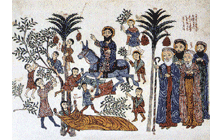|
History of The Syriac Music Church
 Music of the Syriac Orthodox Church is enriched and has a sterling history running from the beginning of our times derived from the ancient Sumerian and Acadian musical period. Music of the Syriac Orthodox Church is enriched and has a sterling history running from the beginning of our times derived from the ancient Sumerian and Acadian musical period.
Excavations proved that music in Mesopotamia began with the Sumerians in 4500 BC and that there were schools of music in that area since that time. Music used in many fields of life especially in the religious ceremonies where it played an imported role.
The Acadian octave (from one note to its equivalent in a higher register) was divided into 24-quartertones. Every eight keys formed a scale. These scales did not get over the entire octave; while they were built on the first four tones only (tetra chord). These tetra chords were combined thereafter with each other until they made up to 3000 different complete scales. A lot of them did not give musical satisfaction and were reduced to almost 200. Today about 10 are in use.
The early Christians sang different type of songs and especially from the Psaltery. It was decided in the early Church to pray and sing in Aramaic the "international" language at that time. Already though, with the establishing of Church, the Acadian seven-tones´ scale was used, the tones which came to Palestine probably with the returning Jews who were liberated by Cyrus about 539 BC. These scales have been used in Jerusalem from 444 BC.
After the destruction of Jerusalem in 70 AC, the early believers moved to Antioch together with Peter the founder of Christian church of Antioch. At that time Antioch was an important bridge between east and west and the point of meeting for other cultures. After the entry of Christianity into the Middle East in the second-third Century, the Christian mass service in Antioch standardized by using the Acadian main tones but in a particular order.
Scales from Acadia took form of eight different tones, a new one for each Sunday, beginning from the Church Consecration’s Sunday (first Sunday in November). These eight scales became the basis of the oriental music which is used until today in all the Middle East, Iran, Greece, Turkey and North Africa.
Bar Dayson (154 – 222 AC) composed 150 hymns. His hymns were so popular that they were sung generations after him. He fell into conflict with the Syrian Orthodox Church management. St. Ephraim (303-373 AC) was the successor of Bar Dayson in introducing new form of music into Church and to eliminate Bar Dayson’s teachings. He wrote nearly thirty thousand hymns and established the women choir.
St. Ignatios I Nurono "the Illuminator" (68-107 AC) founded the two alternating choirs. The holy Chamoun Ibn Sabaghin from Babel entered thereafter this form to the Eastern Church in 341. He called choirs for "Chorous". St. Ephram was followed by many famous church leaders like Rabula (360-435 AC), Shamoun Quqoyo (485-536 AC) and others. St. Jacob d’Orhoy (of Edessa) (+708) gathered all kinds of musical forms in the Syriac Orthodox Church and released them the current musical structure form .
All these hymns are protected today in the Beth Gazo (The Treasury of Chants) which contains up to 2500 different compositions, out of which about 700 or so survive. In the 1992 the Syriac Musician Nuri Iskandar released a notated Beth Gazo.
By: Dr. Abrohom Lahdo and Elias Zazi
|

